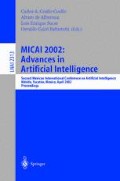Abstract
Portfolio offers an effective way for managing investment risk through diversification. The key issue in portfolio management is how to determine the weight (portion) of each asset in the portfolio, so as to achieve high profit with low risk over a certain period of trading. We propose a learning-based trading strategy for portfolio management, which aims at maximizing the Sharpe Ratio by actively reallocating wealth among assets. The trading decision is formulated as a non-linear function of the latest realized asset returns, and the function can be approximated by a neural-network. Two methods based on supervised learning to train the network are proposed. Experiments show that the proposed trading strategy outperforms the static Sharpe Ratio trading method.
Access this chapter
Tax calculation will be finalised at checkout
Purchases are for personal use only
Preview
Unable to display preview. Download preview PDF.
References
P.H. Algoet and T.M. Cover. Asymptotic optimality and asymptotic equipartition properties of log-optimum investment. The Annals of Probability, 16(2):876–898, 1988.
Y. Bengio. Training a neural network with a financial criterion rather than a prediction criterion. In Y. Abu-Mostafa, A.N. Refenes, and A. Weigend, editors, Decision Technology for Financial Engineering. World Scientific, London, 1997.
T. Cover. Universal portfolios. Mathematical Finance, l(l):1–29, 1991.
T.M. Cover and D.H. Gluss. Empirical bayes stock market portfolios. Advances in Applied Mathematics, 7:170–181, 1986.
T. Goll and J. Kallsen. Optimal portfolios for logarithmic utility, 2000.
D.A. Hammer. Dynamic Asset Allocation: Strategies for the Stock, Bond, and Money Markets. John Wiley and Sons, New York, 1991.
J. Kang, M. Choey, and A.S. Weigend. Nonlinear trading models and asset allocation based on sharpe ratio. In Y. Abu-Mostafa, A.N. Refenes, and A. Weigend, editors, Decision Technology for Financial Engineering. World Scientific, London, 1997.
R. Korn. Optimal Portfolios: stochastic models for optimal investment and risk management in continuous time, pages 11–13. World Scientific Publishing, 1997.
H.M. Markowitz. Portfolio Selection. Journal of Finance, March 1952.
J. Moody and L. Wu. Optimization of trading systems and portfolios. In Y. Abu-Mostafa, A.N. Refenes, and A. Weigend, editors, Decision Technology for Financial Engineering. World Scientific, London, 1997.
P. Samuelson. Lifetime Portfolio selection by dynamic stochastic programming, 1969.
W.F. Sharpe. Capital Asset Prices: A Theory of Market Equilibrium Under Conditions of Risk. Journal of Finance, September 1964.
W.F. Sharpe. The Sharpe Ratio-properly used, it tan improve investment. The Journal of Portfolio Management, pages 49–58, 1994.
L. Xu and Y.M. Cheung. Adaptive Supervised Learning Decision Networks for Traders and Portfolios. Journal of Computational Intelligente in Finance, 5(6):11–15, 1997.
Author information
Authors and Affiliations
Editor information
Editors and Affiliations
Rights and permissions
Copyright information
© 2002 Springer-Verlag Berlin Heidelberg
About this paper
Cite this paper
Liu, Y., Yu, X., Han, J. (2002). Sharpe Ratio-Oriented Active Trading: A Learning Approach. In: Coello Coello, C.A., de Albornoz, A., Sucar, L.E., Battistutti, O.C. (eds) MICAI 2002: Advances in Artificial Intelligence. MICAI 2002. Lecture Notes in Computer Science(), vol 2313. Springer, Berlin, Heidelberg. https://doi.org/10.1007/3-540-46016-0_35
Download citation
DOI: https://doi.org/10.1007/3-540-46016-0_35
Published:
Publisher Name: Springer, Berlin, Heidelberg
Print ISBN: 978-3-540-43475-7
Online ISBN: 978-3-540-46016-9
eBook Packages: Springer Book Archive

